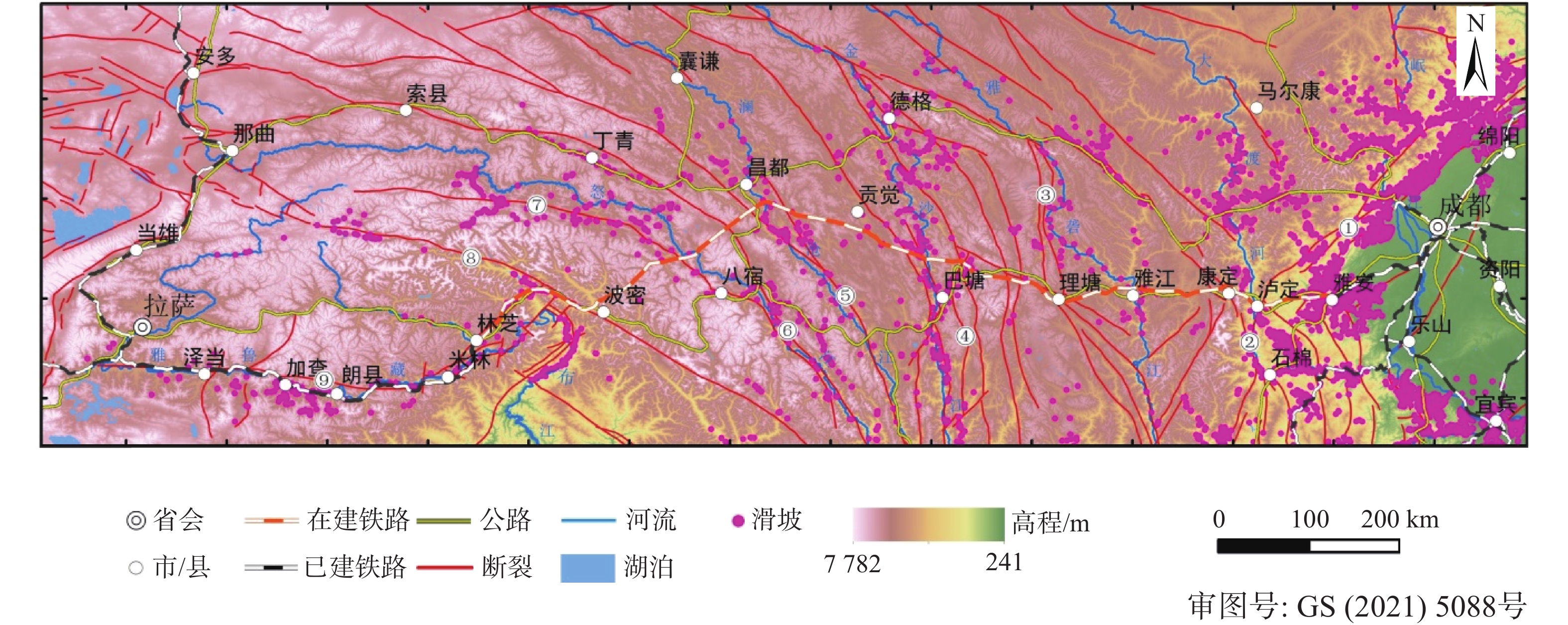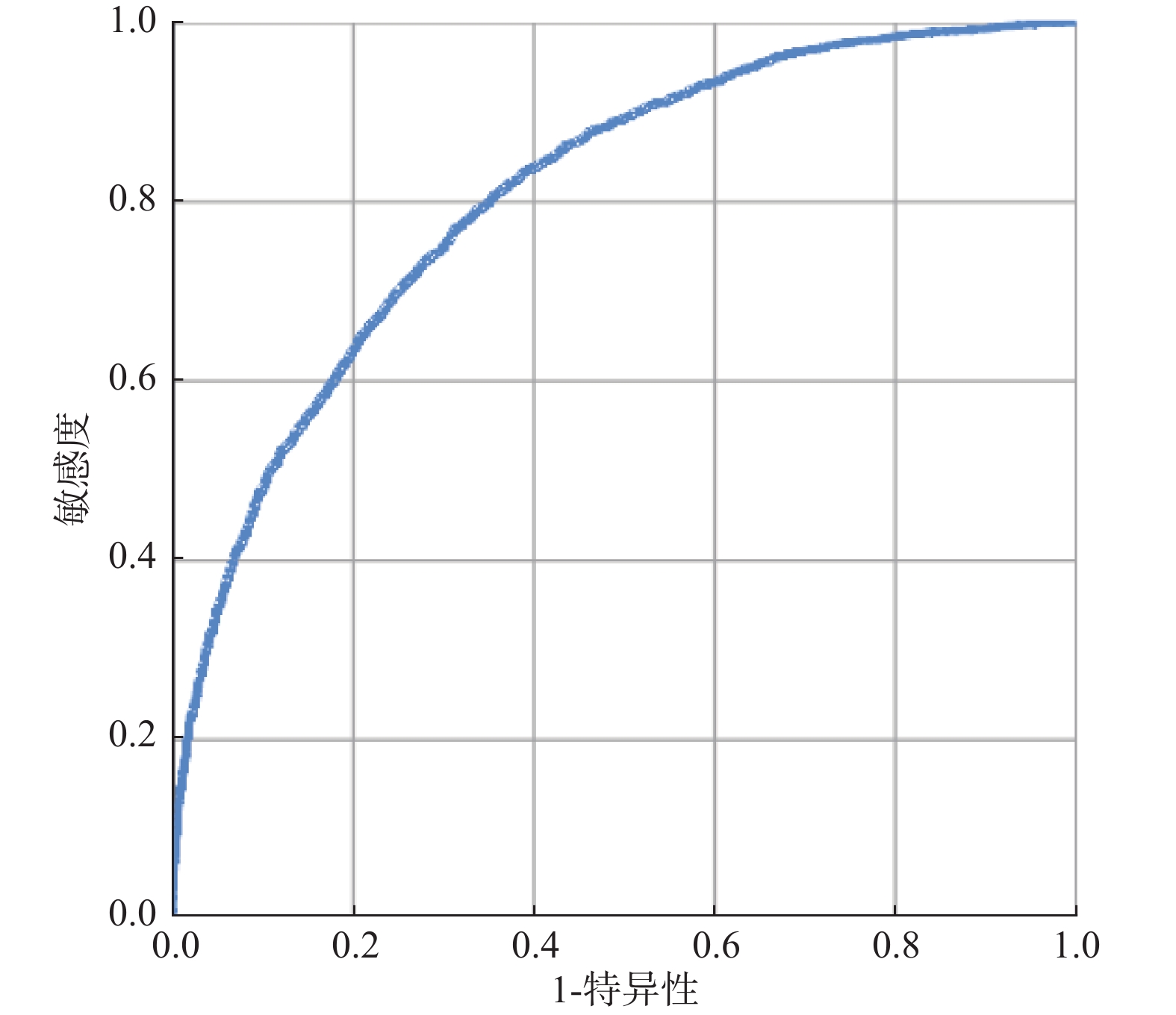Landslide susceptibility mapping in the Sichuan-Xizang traffic corridor using logistic regression- information value method
-
摘要:
川藏交通廊道位于青藏高原中东部,是世界上隆升和地貌演化最快的区域之一。在内外动力耦合作用下,区内滑坡灾害极其发育,严重制约着公路、铁路和水电工程的规划建设。在区域地质资料收集和整理的基础上,选取岩性、坡度、坡向、坡形、地形起伏度、地形粗糙度、断裂密度和河流距离8个因素为评价因子,结合传统信息量和逻辑回归模型的优势,采用逻辑回归–信息量模型对研究区滑坡进行易发性评价。通过对评价因子的多重共线性和显著性检验,得到评价因子不存在多重共线性且均对滑坡发生具有显著影响。采用ROC曲线对评价结果进行检验,其AUC值为0.81,表明评价模型能很好地预测滑坡的发生。易发性评价结果表明:研究区高易发区主要集中龙门山断裂带、金沙江断裂带、澜沧江断裂带、怒江断裂带、边坝–洛隆断裂带等大型活动断裂带控制区,以及区内坡度陡峭、地形起伏度大的大型河流深切河谷的两岸;中易发区在区内分布广泛,主要分布在岸坡较陡、地形起伏度中等的大型河流支流的两岸。研究结果有利于加深对川藏交通廊道滑坡发育分布的认识,也可为研究区的工程规划建设和防灾减灾提供科学依据。
Abstract:Located in east-central Qinghai-Xizang Plateau, the Sichuan-Xizang traffic corridor is one of fastest uplifting and geomorphic evolution regions on the earth. Under the coupling of internal and external dynamics, the landslide in this region is extremely developed, which seriously restricts the planning and construction of highways, railways and hydropower projects. Based on the data collection and analysis of regional geological data, this paper selects lithology, slope gradient, aspect, slope shape, topographic relief, terrain roughness, fault density and distance to rivers as contributing factors. Combined the advantages of traditional information value method and logistic regression, this paper uses the logistic regression-information value method to evaluate the landslide susceptibility of the study area. Through the multi-collinearity test and significance test of the contributing factors, it is found that the selected contributing factors have no multi-collinearity and have a significant impact on the occurrence of landslides. ROC curve is used to test the results of landslide susceptibility, and the AUC value is 0.81, which shows that the model can well predict the occurrence of landslides. The results show that the high risk areas in the study area mainly occur in the regions of the Longmenshan fault zone, Jinshajiang fault zone, Lancangjiang fault zone, Nujiang fault zone and Bianba-Luolong fault zone, as well as on the sides of deep valleys of large rivers with steep slope and large topographic relief. The middle risk areas widely exist on both sides of the tributaries of large rivers. The results are helpful in understanding the development and distribution of landslides in the Sichuan-Xizang traffic corridor, and also provide a scientific basis for the project planning and construction, disaster prevention and mitigation in the study area.
-

-
表 1 信息量统计表
Table 1. Information value of landslide contributing factors
因子 分级 灾害点数量 分级面积/km2 信息量 岩性 Ⅰ 894 149156.89 −0.224 Ⅱ 1131 144023.75 0.046 Ⅲ 1298 147800.05 0.158 Ⅳ 1311 159143.54 0.094 Ⅴ 186 42359.45 −0.535 坡度 <10° 671 148031.37 −0.504 10°~20° 940 136206.86 −0.083 20°~30° 1437 168805.57 0.127 30°~40° 1463 142399.33 0.315 40°~50° 265 38300.46 −0.081 >50° 44 8740.09 −0.399 坡向 平面 0 3054.36 − 北 558 86886.59 −0.155 东北 586 83958.15 −0.072 东 618 74825.46 0.096 东南 735 77610.05 0.233 南 730 84843.91 0.137 西南 590 81023.66 −0.030 西 488 72673.02 −0.111 西北 515 77608.48 −0.123 地形起伏度/m <50 542 141756.94 −0.674 50~100 824 146337.83 −0.287 100~150 1539 172594.47 0.173 150~200 1601 122119.25 0.558 200~250 241 43446.47 −0.302 >250 73 16228.72 −0.511 坡形 凹形坡 2183 301050.94 −0.034 平面坡 39 17135.93 −1.193 凸形坡 2598 324296.81 0.066 地表粗糙度 <1.1 2719 357464.68 0.014 1.1~1.2 1137 159157.91 −0.049 1.2~1.3 563 76548.35 −0.020 1.3~1.4 216 26711.40 0.075 1.4~1.5 89 10704.42 0.103 >1.5 96 11896.92 0.073 断裂密度/(m·km−2) <5 1798 275959.68 −0.141 5~10 930 167439.12 −0.300 10~15 774 99442.21 0.037 15~20 703 57267.24 0.493 20~25 402 30967.41 0.548 >25 213 11408.02 0.912 河流距离/m <200 421 9264.62 1.801 200~400 342 9102.11 1.611 400~600 223 8891.23 1.207 600~800 158 8698.89 0.884 800~1000 154 8549.94 0.876 >1000 3522 597976.89 −0.242 表 2 评价因子共线性诊断
Table 2. Multi-collinearity analysis of contributing factors
因子 TOL VIF 岩性 0.953 1.049 坡度 0.418 2.394 坡向 0.993 1.007 地形起伏度 0.499 2.005 坡形 0.921 1.086 地表粗糙度 0.732 1.367 断裂密度 0.994 1.006 河流距离 0.995 1.005 表 3 模型相关参数
Table 3. Relevant parameters of the model
因子 B 标准误差 Wald Sig. Exp(B) 岩性 1.115 0.087 163.885 1.60E-37 3.051 坡度 2.057 0.098 442.234 3.53E-98 7.824 坡向 0.737 0.070 112.309 3.06E-26 2.089 地形起伏度 1.199 0.097 154.125 2.17E-35 3.317 坡形 1.381 0.179 59.305 1.35E-14 3.978 地表粗糙度 1.433 0.139 106.528 5.65E-25 4.193 断裂密度 1.620 0.094 296.785 1.65E-66 5.054 河流距离 1.096 0.072 228.862 1.06E-51 2.991 常量 −4.908 0.200 601.547 7.72E-133 0.007 表 4 不同易发区滑坡统计结果
Table 4. Relevant parameters of the model
分级 面积/km2 滑坡数量/
个滑坡密度/
(个·km−2)非滑坡数量/
个非滑坡密度/
(个·km−2)高 83464.69 1247 0.0149 147 0.002 中 204267.96 1685 0.0082 779 0.004 低 166022.27 1153 0.0069 1139 0.007 极低 188728.76 735 0.0039 2755 0.015 -
[1] 彭建兵, 马润勇, 卢全中, 等. 青藏高原隆升的地质灾害效应[J]. 地球科学进展,2004,19(3):457 − 466. [PENG Jianbing, MA Runyong, LU Quanzhong, et al. Geological hazards effects of uplift of Qinghai-Xizang plateau[J]. Advance in Earth Sciences,2004,19(3):457 − 466. (in Chinese with English abstract) doi: 10.3321/j.issn:1001-8166.2004.03.018
[2] 彭建兵, 崔鹏, 庄建琦. 川藏铁路对工程地质提出的挑战[J]. 岩石力学与工程学报,2020,39(12):2377 − 2389. [PENG Jianbing, CUI Peng, ZHUANG Jianqi. Challenges to engineering geology of Sichuan-Xizang Railway[J]. Chinese Journal of Rock Mechanics and Engineering,2020,39(12):2377 − 2389. (in Chinese with English abstract)
[3] 张永双, 郭长宝, 姚鑫, 等. 青藏高原东缘活动断裂地质灾害效应研究[J]. 地球学报,2016,37(3):277 − 286. [ZHANG Yongshuang, GUO Changbao, YAO Xin, et al. Research on the geohazard effect of active fault on the eastern margin of the Xizang Plateau[J]. Acta Geoscientica Sinica,2016,37(3):277 − 286. (in Chinese with English abstract) doi: 10.3975/cagsb.2016.03.03
[4] 李郎平, 兰恒星, 郭长宝, 等. 基于改进频率比法的川藏铁路沿线及邻区地质灾害易发性分区评价[J]. 现代地质,2017,31(5):911 − 929. [LI Langping, LAN Hengxing, GUO Changbao, et al. Geohazard susceptibility assessment along the Sichuan-Xizang Railway and its adjacent area using an improved frequency ratio method[J]. Geoscience,2017,31(5):911 − 929. (in Chinese with English abstract) doi: 10.3969/j.issn.1000-8527.2017.05.004
[5] 郭长宝, 吴瑞安, 蒋良文, 等. 川藏铁路雅安—林芝段典型地质灾害与工程地质问题[J]. 现代地质,2021,35(1):1 − 17. [GUO Changbao, WU Rui'an, JIANG Liangwen, et al. Typical geohazards and engineering geological problems along the Ya'an-Linzhi section of the Sichuan-Xizang Railway, China[J]. Geoscience,2021,35(1):1 − 17. (in Chinese with English abstract)
[6] 吴树仁, 石菊松, 张春山, 等. 地质灾害风险评估技术指南初论[J]. 地质通报,2009,28(8):995 − 1005. [WU Shuren, SHI Jusong, ZHANG Chunshan, et al. Preliminary discussion on technical guideline for geohazard risk assessment[J]. Geological Bulletin of China,2009,28(8):995 − 1005. (in Chinese with English abstract) doi: 10.3969/j.issn.1671-2552.2009.08.001
[7] 许冲, 戴福初, 姚鑫, 等. GIS支持下基于层次分析法的汶川地震区滑坡易发性评价[J]. 岩石力学与工程学报,2009,28(增刊2):3978 − 3985. [XU Chong, DAI Fuchu, YAO Xin, et al. GIS-based landslide susceptibility assessment using analytical hierarchy process in Wenchuan earthquake region[J]. Chinese Journal of Rock Mechanics and Engineering,2009,28(Sup2):3978 − 3985. (in Chinese with English abstract)
[8] 牛瑞卿, 彭令, 叶润青, 等. 基于粗糙集的支持向量机滑坡易发性评价[J]. 吉林大学学报(地球科学版),2012,42(2):430 − 439. [NIU Ruiqing, PENG Ling, YE Runqing, et al. Landslide susceptibility assessment based on rough sets and support vector machine[J]. Journal of Jilin University (Earth Science Edition),2012,42(2):430 − 439. (in Chinese with English abstract)
[9] 孙长明, 马润勇, 尚合欣, 等. 基于滑坡分类的西宁市滑坡易发性评价[J]. 水文地质工程地质,2020,47(3):173 − 181. [SUN Changming, MA Runyong, SHANG Hexin, et al. Landslide susceptibility assessment in Xining based on landslide classification[J]. Hydrogeology & Engineering Geology,2020,47(3):173 − 181. (in Chinese with English abstract)
[10] OZDEMIR A, ALTURAL T. A comparative study of frequency ratio, weights of evidence and logistic regression methods for landslide susceptibility mapping: Sultan Mountains, SW Turkey[J]. Journal of Asian Earth Sciences,2013,64:180 − 197. doi: 10.1016/j.jseaes.2012.12.014
[11] 方然可, 刘艳辉, 苏永超, 等. 基于逻辑回归的四川青川县区域滑坡灾害预警模型[J]. 水文地质工程地质,2021,48(1):181 − 187. [FANG Ranke, LIU Yanhui, SU Yongchao, et al. A early warning model of regional landslide in Qingchuan County, Sichuan Province based on logistic regression[J]. Hydrogeology & Engineering Geology,2021,48(1):181 − 187. (in Chinese with English abstract)
[12] UMAR Z, PRADHAN B, AHMAD A, et al. Earthquake induced landslide susceptibility mapping using an integrated ensemble frequency ratio and logistic regression models in West Sumatera Province, Indonesia[J]. CATENA,2014,118:124 − 135. doi: 10.1016/j.catena.2014.02.005
[13] YAO X, THAM L G, DAI F C. Landslide susceptibility mapping based on Support Vector Machine: a case study on natural slopes of Hong Kong, China[J]. Geomorphology,2008,101(4):572 − 582. doi: 10.1016/j.geomorph.2008.02.011
[14] 杜国梁, 张永双, 吕文明, 等. 基于加权信息量模型的藏东南地区滑坡易发性评价[J]. 灾害学,2016,31(2):226 − 234. [DU Guoliang, ZHANG Yongshuang, LV Wenming, et al. Landslide susceptibility assessment based on weighted information value model in southeast Xizang[J]. Journal of Catastrophology,2016,31(2):226 − 234. (in Chinese with English abstract) doi: 10.3969/j.issn.1000-811X.2016.02.042
[15] DU G L, ZHANG Y S, IQBAL J, et al. Landslide susceptibility mapping using an integrated model of information value method and logistic regression in the Bailongjiang watershed, Gansu Province, China[J]. Journal of Mountain Science,2017,14(2):249 − 268. doi: 10.1007/s11629-016-4126-9
[16] 殷坤龙, 晏同珍. 汉江河谷旬阳段区域滑坡规律及斜坡不稳定性预测[J]. 地球科学,1987,12(6):631 − 638. [YIN Kunlong, YAN Tongzhen. Distribution regularity of landslides and prediction of slope instability nearby Xunyang, Han river valley[J]. Earth Science,1987,12(6):631 − 638. (in Chinese with English abstract)
[17] DU G L, ZHANG Y S, YANG Z H, et al. Landslide susceptibility mapping in the region of eastern Himalayan syntaxis, Xizang Plateau, China: a comparison between analytical hierarchy process information value and logistic regression-information value methods[J]. Bulletin of Engineering Geology and the Environment,2019,78(6):4201 − 4215. doi: 10.1007/s10064-018-1393-4
[18] 张玘恺, 凌斯祥, 李晓宁, 等. 九寨沟县滑坡灾害易发性快速评估模型对比研究[J]. 岩石力学与工程学报,2020,39(8):1595 − 1610. [ZHANG Qikai, LING Sixiang, LI Xiaoning, et al. Comparison of landslide susceptibility mapping rapid assessment models in Jiuzhaigou County, Sichuan Province, China[J]. Chinese Journal of Rock Mechanics and Engineering,2020,39(8):1595 − 1610. (in Chinese with English abstract)
-




 下载:
下载:









